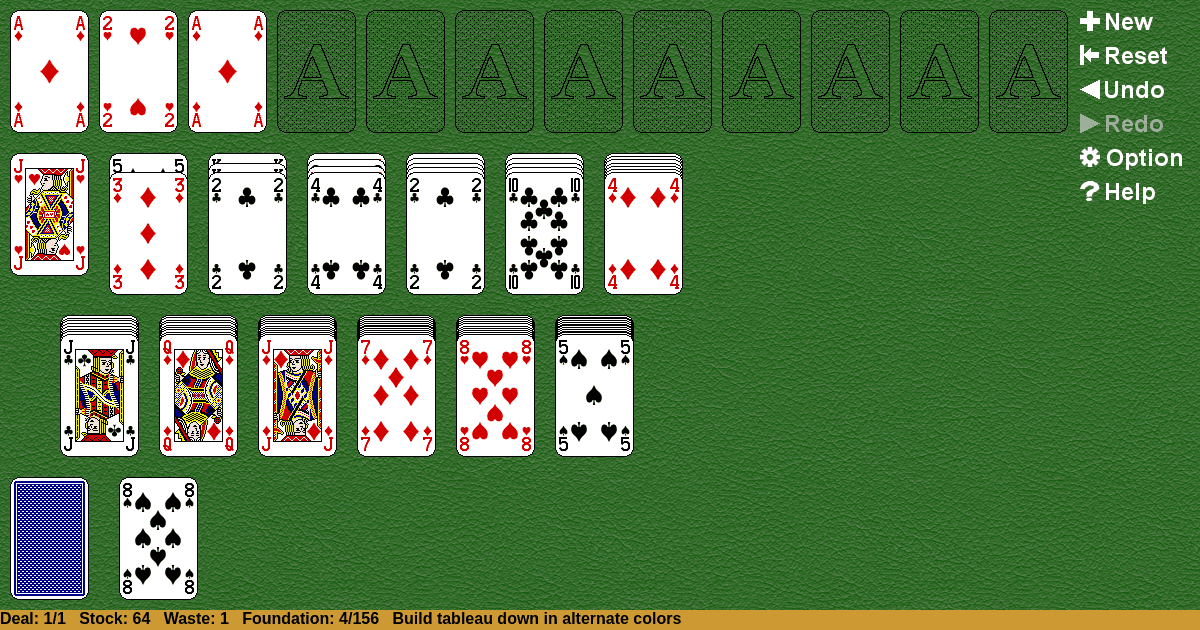Great Triangle
Home |
How to play |
FAQ |
About
How to play Great Triangle?
Game Objective:
The primary goal in Great Triangle Solitaire (commonly known as Pyramid Solitaire) is to remove all cards from the pyramid by pairing exposed cards whose values sum to exactly 13.
Setup & Layout:
- Deck: Standard 52-card deck is used.
- Pyramid Tableau: Deal 28 cards face-up in a triangular (pyramid) formation:
- Row 1: 1 card (top)
- Row 2: 2 cards (partially overlapping the row above)
- Continue, increasing by one card per row, until Row 7 has 7 cards.
- Stock: Place the remaining 24 cards face-down as a single stock pile below the pyramid.
- Waste Pile: As play progresses, a face-up waste pile is formed next to the stock.
- Foundations: There are no traditional foundation piles; removed cards are set aside in a discard area.
Key Play Areas:
- Pyramid: The main tableau of 28 face-up cards arranged in a triangular shape.
- Stock: The face-down pile from which cards are drawn one at a time.
- Waste: The face-up pile where unused stock cards are placed.
- Discard/Removal Area: Where paired cards totaling 13 are placed once removed from play.
Great Triangle Solitaire Rules:
- Card Values:
- Ace = 1
- Number cards = face value (2–10)
- Jack = 11
- Queen = 12
- King = 13
- Pairing and Removal:
- Remove pairs of exposed cards (not overlapped by any other card) whose values sum to 13.
- Kings (value 13) are removed singly, without pairing.
- Pairs can be made from:
- Two exposed cards in the pyramid
- One exposed pyramid card and the top card of the waste pile or the top card drawn from the stock.
- Exposed Cards:
- A card is exposed if no other card overlaps it (i.e., both cards directly below it have been removed).
- Stock and Waste:
- Draw one card at a time from the stock.
- If the drawn card cannot be paired, place it face-up on the waste pile.
- The top card of the waste pile is always available for pairing with exposed pyramid cards or with the next stock card.
- No Suit or Color Restrictions: Pairing is based solely on card value, not suit or color.
Gameplay:
- Remove Available Pairs:
- Identify and remove any pairs of exposed cards in the pyramid that sum to 13, or remove any exposed King.
- Draw from Stock:
- If no more pairs are available, draw the top card from the stock pile.
- Attempt to pair it with any exposed pyramid card or the top card of the waste pile if together they sum to 13.
- If a pair is made, remove both cards. If not, place the drawn card face-up on the waste pile.
- Continue Play:
- Repeat the process: remove pairs, draw from stock, and manage the waste pile.
- Only the top card of the waste pile is available for pairing at any time.
- No Moves Available:
- If no legal moves remain and the stock is exhausted, the game ends.
- Some variants allow the waste pile to be recycled into a new stock a limited number of times, but this is not standard.
Winning & Losing Conditions:
- Winning: The game is won if all cards from the pyramid (and any remaining stock/waste cards) are removed by valid pairs summing to 13.
- Losing: The game is lost if the stock is exhausted and there are no more legal pairs available, with cards still remaining in the pyramid.
Special Rules & Edge Cases:
- Empty Spaces: There is no mechanism for filling empty spaces in the pyramid; once a card is removed, the space remains empty.
- Waste/Stock Cycling: Under standard rules, the stock is dealt through only once. Some variants allow the waste pile to be turned over to form a new stock one or more times, but this is not part of the traditional ruleset.
- Card Accessibility: Only completely exposed cards (not covered by any other card) in the pyramid, the top card of the stock, and the top card of the waste pile are eligible for pairing and removal.
- Multiple Pairing Options: If multiple pairs are available, the player may choose which to remove, but must adhere to the rule that only exposed cards can be used.
- No Redeal by Default: Once the stock is exhausted, no further cards are introduced unless playing a variant that allows redeals.
Note: All rules above are based on the most authoritative and widely recognized sources for Pyramid Solitaire, which is the most common interpretation of "Great Triangle Solitaire". If a different or proprietary variant is intended, please specify for further clarification.

Solitaire Collection
About Great Triangle
Rate (Great Triangle)
4.7 / 5
1,916 votes



























































